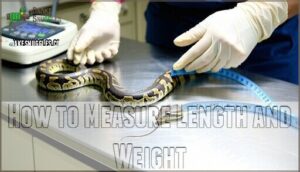This site is supported by our readers. We may earn a commission, at no cost to you, if you purchase through links.

They start as 10-17 inch hatchlings and grow rapidly during their first two years with proper feeding. While they stop growing in length by age 3, they’ll continue bulking up throughout their lives.
**Growth depends on genetics, diet, temperature, and humidity levels.
Think of it like teenagers – they shoot up fast, then fill out gradually. Regular weighing helps you track healthy development and spot any red flags early.
Table Of Contents
- Key Takeaways
- How Big Do Ball Pythons Get?
- How Long for Ball Pythons to Reach Full Size?
- Ball Python Size by Life Stage
- Factors Affecting Ball Python Growth
- Feeding Habits and Growth Rate
- Ball Python Growth Chart and Tracking
- Signs of Healthy and Unhealthy Growth
- Ball Python Care Tips for Optimal Growth
- Frequently Asked Questions (FAQs)
- How long do ball pythons grow?
- How big is a ball python?
- How long does it take a ball python to hatch?
- How big do pythons get?
- What factors affect a ball python’s adult size?
- When do ball pythons reach adulthood?
- How big is a full grown ball python?
- Do ball python bites hurt?
- How fast is a full grown python?
- How often should a ball python eat?
- Conclusion
Key Takeaways
- Your ball python will reach 3-5 feet long and hit full adult size around 3 years old, with females growing larger than males at 4-5 feet compared to males at 3-4 feet.
- You’ll see rapid growth during the first two years as your snake transforms from a 10-17 inch hatchling to nearly adult size, then growth slows dramatically with minimal length increases after age 3.
- Diet quality, feeding frequency, and proper temperature control directly impact your snake’s growth rate, making consistent care essential for reaching their genetic size potential.
- You should track your python’s weight and length monthly to monitor healthy development and spot potential issues early, watching for steady growth rather than dramatic changes.
How Big Do Ball Pythons Get?
You’ll want to know that adult ball pythons usually reach 3 to 5 feet in length, with females growing slightly larger than males.
Most ball pythons hit their full size around 3 years old, though they’ll continue gaining weight and girth throughout their lives.
Average Adult Ball Python Size
Most adult ball pythons reach typical adult length between 3-5 feet, with mature dimensions varying by sex. Weight considerations include 2.5-5.5 pounds for healthy adults.
Your ball python’s average adult size depends on genetics and care. Girth variation becomes noticeable as snakes mature, affecting overall size expectations. Ball python growth rates determine final dimensions.
Maximum Ball Python Size
While ball python growth usually peaks around six feet, remarkable lengths beyond this mark remain rare treasures in the reptile world. Understanding genetic potential helps separate size myths from measurement accuracy when tracking your snake’s development. Proper care influences size substantially.
- A six-foot ball python stretching across your dining table
- Captive extremes reaching weights over six pounds
- Genetic potential unlocking unexpected growth spurts
- Factors affecting growth creating individual size variations
Sex Differences in Size
Female ball pythons outgrow their male counterparts by a significant margin. Sexual dimorphism shows up clearly in mature snakes, where females average 4-5 feet while male size tops out around 3-4 feet. Female girth also exceeds males at similar lengths.
This growth disparity stems from breeding impact and maternal influence on reproduction needs. Snake growth rates differ between sexes from birth weight onward, with factors affecting growth including hormonal differences.
How Long for Ball Pythons to Reach Full Size?
You’ll want to know that most ball pythons reach their full adult size by around three years old, though they continue growing slowly throughout their lives.
The journey from a 10-inch hatchling to a 4-5 foot adult happens fastest in the first year, when your snake can double in size with proper feeding and care.
Growth Timeline and Milestones
Most ball pythons follow predictable growth spurts during their first three years. You’ll notice rapid hatchling development in the initial months, followed by consistent yearly gains that gradually slow. Your snake’s growth rate depends heavily on their feeding regime and seasonal influence on growth patterns.
Here are the key juvenile milestones to track:
- 3 months: Hatchlings double their birth weight and reach 16-24 inches
- 1 year: Most pythons measure 2-3 feet and weigh 500-1,000 grams
- 2 years: Expect 3-4 feet in length with weights approaching 1,500 grams
- 3+ years: Growth enters the adult plateau phase with minimal length increases
After year three, your ball python’s growth practically hits the brakes, focusing mainly on girth rather than length. Factors such as genetics and diet can greatly influence ball python’s weight.
Stages of Development by Age
Your snake’s journey from hatchling to adult unfolds predictably across distinct life phases. During the first year, hatchlings experience rapid growth rate increases, often doubling their birth weight within months. Proper Hatchling Care during this period sets the foundation for healthy development.
Juvenile Milestones occur between years one and three, when your python reaches 2-4 feet and establishes consistent feeding patterns. A proper feeding regime during this stage accelerates growth substantially.
Adult Maturity arrives around three years, marking the shift to slower growth focused on girth rather than length. Senior Snakes over ten years maintain size but benefit from adjusted care.
Seasonal influence on growth affects metabolism year-round, while individual Lifespan Factors determine your snake’s final development potential.
Ball Python Size by Life Stage
You’ll watch your ball python transform dramatically as it moves through distinct life stages, from a tiny 10-inch hatchling to a sturdy 4-5 foot adult.
Understanding these growth phases helps you provide proper care and realistic expectations for your snake’s development timeline.
Hatchling Size and Weight
Your baby ball python arrives as a tiny package measuring 10 to 17 inches in hatchling length. Birth weight ranges from 40 to 100 grams—about the weight of three golf balls. Genetic influence plays a major role in these initial measurements.
After their first shed within weeks, hatchlings are ready for early feeding. This growth rate foundation determines how quickly your ball python will develop into adulthood.
Juvenile Growth Patterns
Young ball pythons grow rapidly during their first year, often doubling their hatchling size. You’ll notice impressive growth spurts as your juvenile develops, with proper diet and feeding habits driving their growth rate.
Early feeding schedules and consistent hatchling care support healthy development. Shedding frequency increases during active growth periods, indicating good juvenile health and proper environmental conditions.
Subadult and Adult Size Benchmarks
Once your ball python hits the two-year mark, you’ll notice subadult growth spurts tapering off as they approach their size plateau. Adult weight ranges usually span 2.5-5.5 pounds, with mature girth differences becoming more apparent. Environmental factors and feeding habits still influence their metabolic processes, but growth rate slows dramatically.
Key subadult and adult benchmarks:
- Two years: 3-4 feet length, 1000-1500 grams weight
- Three years: Near-adult size of 3-5 feet achieved
- Adult females: 4-5 feet average, heavier girth
- Adult males: 3-4 feet average, leaner build
- Post-maturity: Minimal length growth, continued weight gain
Factors Affecting Ball Python Growth
Your ball python’s growth isn’t set in stone—several key factors determine how big and how quickly they’ll reach their full size. Genetics, diet quality, and environmental conditions like temperature work together to shape your snake’s development timeline and eventual adult dimensions.
Genetics and Morph Variability
Contrary to popular belief, your ball python’s genetics won’t dramatically alter its adult size. While over 4,000 morphs exist through genetic mutations, these primarily affect color and pattern rather than growth. Designer morphs from captive breeding programs combine recessive genes for striking appearances, but morph inheritance rarely influences length.
Most polygenic traits controlling size remain consistent across morphs, meaning your captivebred snake will reach typical adult dimensions regardless of its stunning visual genetics.
Breeders use genetics to predict traits, and Punnett squares help calculate offspring possibilities.
Diet and Nutrition
Everything you feed your ball python directly impacts their growth potential. Ball Python Feeding requires consistent meal sizes matched to your snake’s body width—oversized prey won’t accelerate growth but creates feeding problems.
Prey variety isn’t necessary since rodents provide complete nutrition, eliminating supplementation needs. Proper frozen rodent selection is essential for their health.
Focus on obesity prevention through proper diet scheduling rather than constant feeding. Hydration importance remains secondary since snakes get moisture from prey. Your feeding habits determine whether your python reaches their genetic size potential.
Temperature and Environmental Conditions
Temperature requirements directly impact your ball python’s growth rate and overall health. Proper temperature regulation aids healthy metabolism and digestion. You’ll need to maintain a thermal gradient with basking spots at 88-92°F and cool sides at 75-80°F.
Humidity levels between 50-60% prevent respiratory issues, while seasonal variation isn’t necessary.
Your enclosure design should include habitat temperatures that promote ideal growth patterns, and a secure and locked enclosure is essential to prevent escapes.
Feeding Habits and Growth Rate
Your ball python’s feeding habits directly control how fast it’ll grow, making meal timing and prey size vital decisions for reaching full adult size.
You’ll need to adjust feeding frequency from weekly meals for juveniles to every 1-2 weeks for adults, while ensuring prey matches your snake’s mid-body width to fuel steady growth without health risks.
Feeding Frequency by Age
Your Ball Python’s feeding schedule changes dramatically as they age. Hatchlings need weekly meals for rapid growth, while adults can wait 1-2 weeks between feedings. Getting this timing right promotes healthy digestion and prevents obesity.
Here’s your age-based feeding frequency guide:
- Juvenile Feeding (0-12 months): Feed weekly to fuel their explosive growth phase
- Subadults (1-2 years): Shift to every 10-14 days as growth slows
- Adult Schedules (3+ years): Feed every 2 weeks for maintenance and health
Frequency impact on your snake’s development can’t be overstated. Consistent feeding habits impact everything from growth rate to overall health. Varied diets with proper scheduling create the foundation for a thriving Ball Python.
Prey Size and Type Impact
Nutrition becomes your secret weapon when feeding ball pythons correctly. Rodent nutritional value varies substantially—African Soft Fur rats build leaner muscle than standard mice, while prey size progression should match your snake’s thickest body part.
Frozen vs. live doesn’t affect growth dramatically, but feeding variety matters. Alternating between mice, rats, and occasional chicks mimics wild feeding habits impact.
Your feeding schedule determines whether frozen rodents support steady development or create nutritional gaps leading to obesity prevention challenges.
Overfeeding and Underfeeding Risks
Finding the right balance with frozen rodents prevents serious Ball Python Health complications. Overfeeding causes obesity dangers, while underfeeding creates malnutrition effects that stunt growth. Both feeding imbalance scenarios lead to health complications.
You’ll notice growth stunting with poor diet choices. Follow proper Ball Python Feeding Tips: stick to scheduled meals and appropriate prey sizes to avoid these risks.
Ball Python Growth Chart and Tracking
You’ll want to track your ball python’s growth carefully to guarantee they’re developing properly and reaching expected milestones. Regular measurements help you spot potential health issues early and adjust feeding schedules as your snake matures from a tiny hatchling to its full adult size.
How to Measure Length and Weight
You’ll need accurate scales and measuring techniques to track your ball python’s growth properly. Use a digital scale that measures in grams for precise weight readings. For length, gently stretch your snake along a measuring tape while it’s calm. Weight fluctuations are normal, but consistent growth indicates good ball python health. To maintain healthy skin, consider specialized reptile products for their enclosure.
| Measurement Tool | Purpose |
|---|---|
| Digital Scale (grams) | Track weight changes accurately |
| Measuring Tape | Record total body length |
| Notebook/App | Document measurements monthly |
| Camera | Visual growth comparison photos |
| Calm Environment | Reduce stress during handling |
Watch for length discrepancies or growth anomalies during your ball python care routine. Proper ball python handling makes measuring easier and safer for both you and your snake.
Recording Growth Over Time
Consistent tracking transforms your ball python’s care from guesswork into science. You’ll need Growth Measurement Tools like a digital scale and measuring tape. Create a simple spreadsheet for Data Logging Methods, recording monthly weight and length measurements. Add Photographic Documentation alongside each entry—photos reveal subtle changes numbers miss. This Longitudinal Study Benefits approach helps refine Ball Python Care decisions about diet and frozen rodents timing.
| Month | Weight (grams) | Length (inches) |
|---|---|---|
| 1 | 450 | 24 |
| 6 | 850 | 32 |
| 12 | 1,200 | 38 |
Consider Community Data Sharing with fellow keepers using feeding tongs and similar care methods.
Recognizing Growth Plateaus
Growth slowdown becomes obvious when your ball python’s monthly measurements stay consistent. Most plateau causes include reaching genetic limits or switching to maintenance feeding schedules around age three.
| Plateau Sign | What You’ll Notice |
|---|---|
| Weight stagnation | Monthly weigh-ins show minimal changes |
| Longer shed cycles | Ball Python Shedding Cycle extends markedly |
| Reduced appetite | Snake refuses meals more frequently |
| Size consistency | Length measurements remain static for months |
Identifying plateaus early helps you distinguish normal adult development from stunted growth requiring intervention strategies.
Signs of Healthy and Unhealthy Growth
You can spot healthy growth by watching your ball python’s steady weight gain and regular shedding cycles every 4-6 weeks.
Warning signs like rapid weight loss, missed sheds, or a visibly thin spine signal it’s time to check your care routine and possibly consult a reptile vet.
Indicators of Proper Growth
Healthy ball pythons show steady weight gain that matches their length increases. Monitor your snake’s weight-length ratio monthly. Contact veterinary care if growth stalls unexpectedly.
You’ll notice consistent shedding frequency every 4-6 weeks, active muscle tone when handling, and alert activity levels during feeding time. Their body condition should feel firm but not rigid.
Proper diet and stable temperature promote regular shedding cycles. Look for smooth and shiny scales as another sign of health.
Signs of Obesity and Underweight
Spotting weight problems in ball pythons requires checking specific body markers. Obesity shows through fat rolls near the head, visible skin between scales, and a loaf-shaped body profile. Your snake’s Body Condition Score should stay between 3-5 on assessment scales. Underweight ball pythons display sharp rib visibility, concave bellies, and wrinkled skin folds.
Monitor activity levels regularly—sluggish movement often signals excess weight, while lethargy can indicate malnutrition. Proper scale condition remains flat and taut in healthy specimens. Weight monitoring with monthly measurements helps track concerning changes before they become serious health issues.
Health Issues Affecting Growth
Several health problems can seriously impact your ball python’s growth rate. Respiratory issues from poor humidity cause breathing problems that reduce appetite. Metabolic disorders disrupt how your snake processes nutrients from frozen rodents. Parasite impact includes mites and internal parasites that steal nutrition and cause weight loss. Scale rot from damp conditions affects feeding behavior. Genetic diseases in certain morphs can stunt development. Problems with shedding often indicate underlying health issues.
When you notice growth concerns, contact a vet experienced in ball python veterinary care immediately.
Ball Python Care Tips for Optimal Growth
You’ll enhance your ball python’s growth potential by creating the right environment and maintaining consistent care practices. Proper enclosure setup, temperature control, and stress-free handling work together like a well-oiled machine to support healthy development throughout your snake’s life.
Enclosure Size and Setup
Your ball python’s enclosure acts like their personal apartment – it needs the right size and setup for ideal growth. Start with a 40-gallon habitat for adults, featuring secure hiding spots on both warm and cool sides.
Choose appropriate substrate types like cypress mulch or aspen shavings for comfort. Consider browsing a retailer for ball python supplies to guarantee proper care.
Add enclosure enrichment like branches or fake plants to create a natural ball python habitat setup that promotes healthy development.
Humidity and Temperature Regulation
Proper Temperature Regulation forms the backbone of healthy Ball Python growth. You’ll need consistent Heating Methods like under-tank heaters or ceramic heat emitters to create the perfect Temperature Gradient—95°F on the warm side, 78°F on the cool side.
Humidity Monitoring becomes equally important, maintaining 40-60% normally and boosting to 70% during shedding. Consistent monitoring is key, as ideal humidity levels should range between 55-70%.
Poor Enclosure Ventilation causes stagnant air and Shedding Issues that’ll stunt growth.
Handling and Stress Management
Frequent handling stresses Ball Pythons, especially during Ball Python Shedding cycles when their temperament changes. These ectothermic reptiles need time between sessions to recover.
You’ll want to handle your snake every 7-10 days maximum. Recognizing Stress signals like defensive posturing or refusing food helps you adjust your approach.
Safe Handling means supporting their body weight and avoiding sudden movements. Reducing Stress through proper Handling Frequency directly aids healthy growth patterns.
Frequently Asked Questions (FAQs)
How long do ball pythons grow?
Ever wondered about your ball python’s journey to full size? You’ll watch them grow from 10-17 inches as hatchlings to 3-5 feet as adults, reaching their mature length in approximately three years.
How big is a ball python?
Adult ball pythons usually reach 3-5 feet long, with females growing larger than males. You’ll find most weigh 5-5 pounds when fully grown, making them perfectly manageable pets.
How long does it take a ball python to hatch?
Picture waiting two months for your slow cooker to finish—that’s about how long ball python eggs take to hatch.
Ball python eggs usually take 55 to 60 days to hatch when incubated at an ideal temperature of 88-90°F (31-32°C). You’ll need patience for this marathon.
How big do pythons get?
Ball pythons usually reach 3-5 feet long, with females growing larger than males. Most hit adult size by three years old, though they’ll keep growing slowly throughout their lives.
What factors affect a ball python’s adult size?
Size isn’t written in stone for your ball python. Genetics play the biggest role, determining whether you’ll get a petite 3-footer or sturdy 5-footer.
Diet quality, feeding frequency, and environmental conditions like temperature also influence their final dimensions.
When do ball pythons reach adulthood?
Your ball python reaches sexual maturity around 18-24 months, but they’re considered fully adult at 3 years old when they’ve reached their maximum size potential and growth substantially slows down.
How big is a full grown ball python?
Your full-grown ball python will usually reach 3-5 feet long and weigh 5-5 pounds. Females grow larger than males, sometimes reaching 6 feet, though that’s rare.
Do ball python bites hurt?
A ball python bite feels like tiny pinpricks and isn’t very painful. Ball pythons don’t have strong jaws, making bites much less painful than common injuries.
How fast is a full grown python?
When fully grown, you’ll find these gentle giants aren’t speed demons—they cruise at roughly one mile per hour. Their laid-back lifestyle doesn’t require Olympic sprinting skills.
How often should a ball python eat?
Your juvenile ball python needs weekly meals, while adults eat every one to two weeks. Feed thawed frozen rodents that match your snake’s mid-body width for ideal health.
Conclusion
Ready to welcome your new slithery companion? Understanding how big do ball pythons get and how long does it take for them to grow helps you prepare for their journey from tiny hatchling to adult.
You’ll watch them transform from a 10-inch baby to a 3-5 foot adult over three years. With proper care, consistent feeding, and ideal conditions, your python will reach their genetic potential.
**Track their progress, maintain proper husbandry, and enjoy watching your snake develop into a healthy, beautiful adult.
**

















